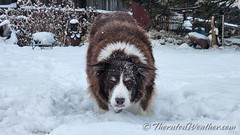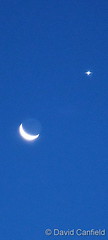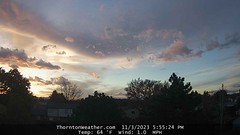
Some weeks on the Denver weather history calendar just seem to be busier than others and such is the case with this one. Numerous significant snow and wind events dominate the period around Thanksgiving as well as some examples of extreme cold.
From the National Weather Service:
21-25
In 1952…snowfall of 6.2 inches was measured at Stapleton Airport where northeast winds gusted to 17 mph on the 21st.
23-24
In 1992…a pre-Thanksgiving blizzard belted metro Denver. Gusty north to northeast winds at 30 to 40 mph caused near-whiteout conditions as visibilities were often below 1/4 mile. The strong winds drove snow into drifts of more than 4 feet. Hundreds of holiday travelers were stranded when airlines canceled flights at Stapleton International Airport where snowfall totaled 7.6 inches and north winds gusted to 37 mph. Blizzard conditions began around mid- morning on the 23rd and ended by mid-afternoon…but heavy snow fell through the night. Snowfall totaled: 12 inches at Conifer…Morrison…and Wheat Ridge; 19 inches at Littleton; 16 inches at Castle Rock; 9 inches in Brighton; 8 inches in Aurora; and 6 inches in Parker.
In 1993…a moist upper level disturbance dumped heavy snow over most of Colorado. Snowfall amounts averaged 5 to 8 inches across metro Denver. Snowfall totaled 4.6 inches at Stapleton International Airport where northeast winds gusted to only 20 mph on the 23rd. The very cold air mass caused the temperature to dip to a record low of 8 degrees below zero on the 24th. The temperature that day climbed to only 9 degrees…also setting a record low maximum for the date.
24
In 1915…Chinook winds from the southwest sustained to 40 mph with gusts to 46 mph warmed the temperature to a high of 61 degrees. It was windy most of the day.
In 1949…the low temperature dipped to 56 degrees…the all-time record highest minimum temperature ever recorded during the month of November.
In 1960…violent wind gusts caused some damage in Boulder. West winds gusted to only 22 mph at Stapleton Airport.
In 1980…a snow storm brought 3 to 6 inches of snow across metro Denver. At Stapleton International Airport…only 2.1 inches of snow fell.
In 1989…high winds were recorded in Boulder with a gust to 64 mph. West winds gusted to only 24 mph at Stapleton International Airport.
24-25
In 1908…heavy snowfall totaled 7.0 inches over downtown Denver overnight. North winds were sustained to 15 mph.
In 1930 strong winds raked the Front Range eastern foothills. Winds gusted to 40 mph at Valmont just east of Boulder where minor damage occurred.
In 1970…strong Chinook winds warmed Boulder. At the National Center for Atmospheric Research in Boulder…wind gusts reached 97 mph…while in downtown Boulder winds peaked to 69 mph. Some minor damage occurred. Northwest winds gusted to 39 mph at Stapleton International Airport…and the high temperature warmed to 76 degrees on the 25th…setting a new record maximum for the date.
25
In 1877…northwest winds were sustained to 50 mph.
In 1902…northwest winds were sustained to 45 mph with gusts to 48 mph. The strong apparent bora winds warmed the temperature to a high of only 45 degrees.
In 1943…snowfall of 4.0 inches was the only measurable snow of the month. North winds were sustained to 17 mph.
In 1958…strong pre-frontal Chinook winds struck Boulder and the eastern foothills. A wind gust to 100 mph was recorded northwest of Denver. A gust to 88 mph occurred at Rocky Flats south of Boulder. The windstorm caused considerable structural damage to residential sections of north metro Denver.
In 1959…strong winds raked the eastern foothills including Boulder and Eldorado Springs. Wind gusts to 100 mph were estimated at the Matterhorn restaurant located atop Rocky Flats south of Boulder.
In 1993…a wind gust to 99 mph was recorded atop Squaw Mountain near Idaho Springs.
In 1998…strong winds developed over portions of the Front Range foothills for a brief time following the passage of a weak upper level disturbance. A wind gust to 71 mph was measured atop Blue Mountain near Coal Creek Canyon.
In 1999…strong Chinook winds developed in and near the foothills. Peak wind reports included 100 mph at the Eldora Ski Resort and 77 mph at the National Center for Atmospheric Research mesa lab above Boulder. West winds gusted to 38 mph at Denver International Airport.
In 2010…high winds developed in the foothills of Boulder County. A gust to 75 mph occurred 5 miles northwest of Boulder with a gust to 72 mph at the National Center for Atmospheric Research mesa lab above Boulder. West winds gusted to 24 mph at Denver International Airport.
25-26
In 1887…snowfall totaled 2.9 inches in the city. This was the only measurable snow of the month. Northeast winds were sustained to 18 mph on the 26th when the temperature dipped to 12 degrees below zero.
In 1959…a sharp cold front produced a northwest wind gust to 51 mph…followed by snow and falling temperatures from a high of 60 degrees to a low of 23 degrees at midnight on the 25th. Snowfall totaled 4.4 inches at Stapleton Airport before ending early on the 26th.
In 1972…winds gusted to 104 mph at the Rocky Flats plant south of Boulder. Gusts to 70 mph were recorded at the National Bureau of Standards in Boulder…while in downtown Boulder winds peaked to 68 mph. Some damage was reported. Northwest winds gusted to 47 mph at Stapleton International Airport on the 26th.
In 1984…blowing snow closed I-70 east of Denver…stranding over a thousand travelers in Limon. Denver received only 2.3 inches of snowfall. North winds gusted to 31 mph at Stapleton International Airport.
In 1999…strong Chinook winds redeveloped overnight in and near the foothills. Peak wind gusts included 72 mph atop Blue Mountain near Wondervu and at the National Center for Atmospheric Research mesa lab above Boulder.
25-27
In 1978…heavy snowfall of 6.0 inches was measured at Stapleton International Airport where north winds gusted to 20 mph. Most of the snow…4.8 inches…fell on the 25th. The greatest amount of snow measured on the ground was 5 inches due to settling and melting.
Continue reading November 24 to November 30: This Week in Denver Weather History →
































































































































































